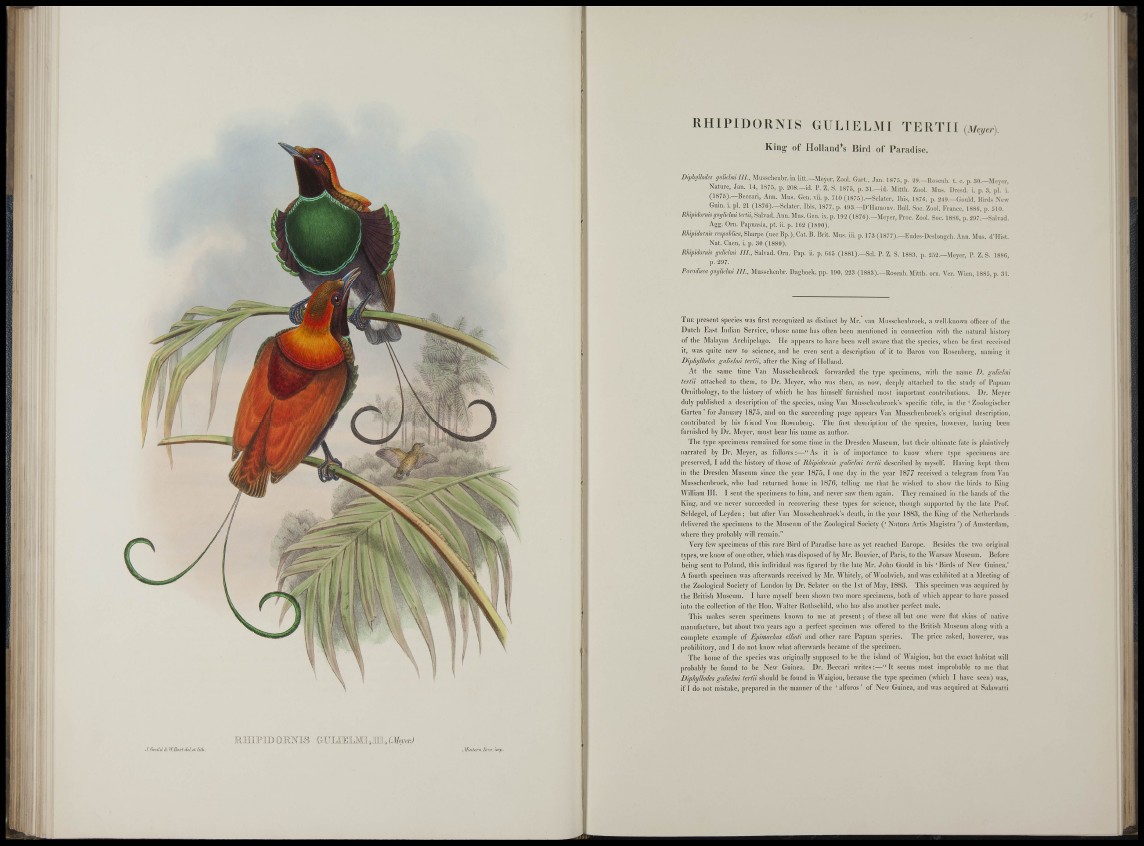
! \
Ir I
a H i P I D O M N I S GULIELMI ,111, (. \hrrr.)
.lC'cnld&. Kll<U-t dd.et Jitk. .\pntj;l-ll B)-!'-'. iltlfi.
i " If.
'II!i I !• m
RHIPIDORNIS GULIELMI TEIITII
King- of Holland's Bird of Paradise.
DlphjlMes gididmillL, Mussclienbr. in litt.—Meyer, Zool. Gart., Jan. 1875, p. 29.-Rosenl). t. c. p .'iO-Meyer
Nature, Jan. 14, 1870, p. 2n8.-id. P. Z. S. 187r,, p. :u.-icl . Mitth. Zool. Mus. Dre^d. i. p. 3, pi. i
(1875).—Beceari, Ann. Mus. Gen. vii. p. 710 (1875) . -Sclater , Ibis, 1S7IÍ, p. 24i).-C;ould, Birds .New
Guin. i. pi. 21 (187(i).—Selater, Ibis, 1877, p. 493.—ir Ilamonv. Bull. Soe. Zool. France, 188«, p. 510.
RUpkhrnisgugUdmiUrtii, Salvad. Ann. Mus. Gen. ix. p. 1!)2 (1870).—Meyer, Proe. Zool. Soe. 188(i, p. 297.-Salvad.
Agg. Orn. Papuasia, pt. ii. p. lf>2 (1890).
Rhipidonm respiMca, Sharpe (nee Bp.), Cat. B. Brit. Mus. iii. p. 173 (1877).—Endes-Deslonaeli. Ann. Mus. d'llist.
Nat. Caen, i. p. 30 (1880).
Rhipidorim gulielmi III., Salvad. Orn. Pap. ii. p. (;-15 (1881).—Sel. P. Z. S. 1883, p. 2,Í2.—Meyer, P. Z. S. 1880,
p. 297.
Paniisea gugliami III., Musselienbr. Dagboek, pp. 190. 223 (1883).—Rosenb. Mitth. orn. Ver. Wien, 1885, p. 31.
THE present spccies was first recognized as distinct by Mr.' van Miissclicnbi-oek, a well-known officer of tlic
Dutch East Indian Service, wliose name lias often been mentioned In conneclion wltli the natural history
of the Malayan Archipclago. He appears to have been well aware that the species, when lie first received
It, was qnlte new to science, and he even sent a description of It to liaron von Rosenberg, namhiif it
Diphyllodes guUetmi tertii, after the King of Holland.
At the same time Van Musschenbroek forwarded tlie type spcclineiis, with the name I), gulielmi
terlii attached to them, to Dr. Meyer, who was then, as now, deeply attached to the study of Papuan
Ornithology, to the history of which he has himself fiiriilshed most important contributions. Dr. Meyer
duly published a description of the species, using Van Mussclieiiliroek's specific title, iii the ' Zoologlscher
Garten ' for January 1875, and on the succeeding page appears Van Musschenbroek's original description,
contributed by his friend Von Rosenberg. The first description of the species, however, having been
furnished liy Dr . Meyer, must bear his name as author.
The type specimens remained for some time In the Dresden Museum, but their ultimate fate Is ])lalntivcly
narrated by Dr. Meyer, as follows:—"As it Is of Importance to know where type specimens are
preserved, I add the history of those of Rhipidorms gidiclmi tertii descrllied by myself. Having kept tliem
111 the Dresden Museum since the year 1875, I one day in the year 1877 received a telegram from Van
Musschenbroek, who had returned home in 187G, telling ine that he wished to show the birds to King
William III. I sent the specimens to liim, ami never saw them again. They remained in the hands of the
King, and we never succeeded In recovering these types for science, tliongh supported by the late I'rof.
Schlegel, of Leyden ; hut after Van Musschenbroek's death. In the year 1883, the King of the Netherlands
delivered the specimens to the Mnscum of the Zoological Society (* Natur a Artls Maglstra ') of Amsterdam,
where they probably will remain."
Very few speelmcns of this rare Bird of Paradise have as yet reached Europe. Besides the two original
types, we know of one other, which was disposed of by Mr. Bouvier, of Paris, to the Warsaw Museum. Before
being sent to Pohiiid, this individual was figured by the late Mr. John Gould In his ']51r(ls of New Guinea.'
A fourth specimen was afterwards received by Mr. AVhitely, of Woolwich, and was exhibited at a Meeting of
the Zoological Society of London by Dr. Sclater on the 1st of May, 1883. This specimen was acquired by
the British Museum. I have myself been shown two more specimens, both of which a]ipear to have passed
Into the collection of the Hon. Walter Rothschild, who has also another perfect male.
This makes seven specimens known to me at present; of these all but one were flat skins of native
manufacture, hut about two years ago a ]icrfect S])ecimen was ollered to the British Museum along with a
complete example of Epimaclms ellioti and other rare Papuan species. The price asked, however, was
prohibitory, and I do not know what afterwards became of the specimen.
The home of the species was originally supposed to be the island of Waiglou, hut the exact habitat will
probably be found to be New Guinea. Dr. Beccarl writes :—" It seems most Improbable to me that
Diphyllodes gulielmi tertii sliould be found In Waiglou, because the type specimen (which I have seen) was,
if I do not mistake, prepared In the manner of the ' alfnros' of New Guinea, and was acquired at Salawatti